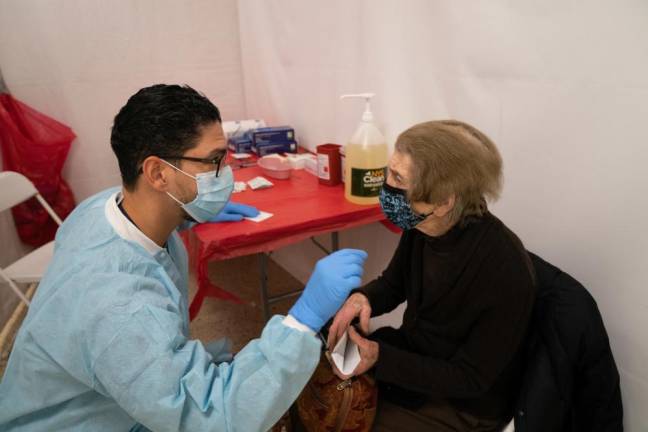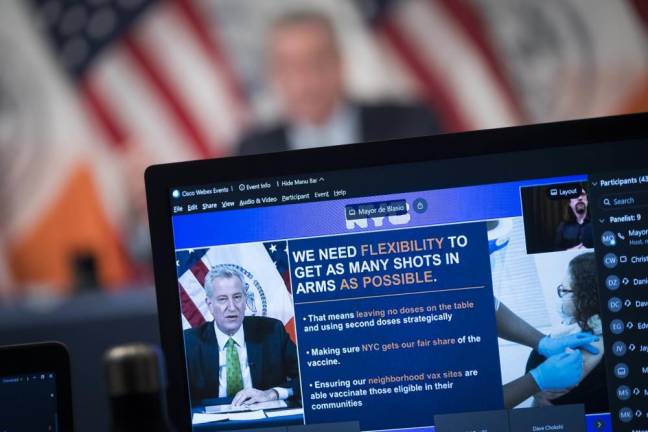Will We Finally Have Enough Vaccine?
Restaurants to reopen at limited capacity while worries grow about new COVID variants


It is surely hard in our year-old COVID-19 crisis to hear signals about our future amidst all the noise of the day. Will canceled appointments be rescheduled? Will mutations of the virus overwhelm the progress against it? Will Governor Andrew Cuomo find a date who will dine with him indoors on Valentine’s day?
Yet behind these anxious and urgent questions it is possible, just possible, that this was the week New York turned a corner on the pandemic. Mayor Bill de Blasio announced he would call city employees back from working at home come May, and Cuomo said that restaurants in New York City could resume serving inside on February 14, at one quarter of their full capacity.
The immediate explanation is that the key metrics of the pandemic – positivity rate, new cases, hospitalizations and deaths — have all stabilized and show signs of starting to decline.
What is new this week is a change in the larger reality. For a year the story of the pandemic has been a desperate scramble to solve shortages. Not enough masks and protective equipment. Too few ventilators. Not enough reliable information. Not enough tests or enough staff to trace those found to be infected and cut off the spread.
And of course in the past six weeks, not enough of the new vaccines.
But for the first time it was possible to see the new world coming just around the bend, where there will be adequate supply of vaccine, perhaps even a bit of a surplus.
The key news came early last Friday morning when Johnson & Johnson of New Brunswick, New Jersey, announced that clinical trials had demonstrated its new one-shot vaccine was safe and effective in preventing serious COVID-19.
There was considerable hand-wringing that the results were not as good as the two vaccines already in use in the United States, demonstrating that we preserved our ability to find the dark cloud in any silver lining.
“The Good Enough”
Dr. Anthony Fauci, President Biden’s chief medical adviser, rushed to say that were it not for the extraordinary 94 to 95 percent effectiveness of those vaccines, from Moderna and Pfizer/BioNTech, the new Johnson & Johnson vaccine’s 66 percent effectiveness would be welcomed as spectacular.
“Don’t let the perfect get in the way of the good enough,” Fauci’s colleague, Kizzmekia Corbett, who was instrumental in developing the Moderna jab at the Viral Pathogenesis Laboratory at the National Institutes of Health, said on Twitter.
Heath officials noted that all three of the vaccines prevented virtually all hospitalization and death from COVID-19 in their clinical trials.
The relative effectiveness, which is a slightly technical measure comparing the health of those vaccinated in a trial with those who received a placebo, is less significant in this moment than what the arrival of the new vaccine will do for supply.
Johnson & Johnson says it is already making the vaccine and can begin distribution as soon as the federal government authorizes emergency use, likely toward the end of February. The company has committed to delivering 100 million doses by summer.
Since this vaccine requires only one dose (a trial is being conducted of giving a booster dose after three months), there will soon be enough vaccine to immunize all 260 million adults in the United States by summer.
There is evidence that current vaccines may not work as well against some mutations, in particular the one called the South Africa variant (although whether it really originated there is unknown). Drug companies are tinkering with their vaccines to address this and, in the meantime, health officials say that slowing the spread through aggressive vaccination and continued adherence to distancing, masks and handwashing are the best protection against the variants taking hold.
Efficient and Fair Distribution
So the focus begins to shift from managing scarcity to scheduling vaccines in an efficient and fair way.
Fair seems to be one of the continuing challenges.
The newly opened distribution site at the Fort Washington Armory, normally used for track meets, was criticized for allowing residents of Westchester to sign up. When this was reported by The City, the digital news site, the managers said they would no longer take appointments from outside New York City and would give preference to residents of upper Manhattan the Bronx.
This no doubt will take time to kick in. This correspondent visited the armory the next day and the volunteer medical staff was more diverse than the eager patients, who looked mostly like the line for breakfast at Barney Greengrass.
After the flap over Washington Heights, and a national story from the Associated Press showing stark racial disparities in vaccine distribution in cities and states that had been reporting such data, de Blasio for the first time released a breakdown of the racial and ethnic disparity in who has been getting vaccinated.
This data showed that 48 percent percent of those vaccinated so far are white, compared to 32 percent of the city’s population. Blacks were 11 percent of those vaccinated versus 24 percent of the population. For Hispanics, the figures were 15 percent vaccinated and 29 percent of the population. Asians composed 15 percent of those vaccinated, roughly the same as their share of the city’s population.
The data was imperfect since only about six in ten of those vaccinated reported racial or ethnic identity. However, the mayor said the disparity was “profound” and unacceptable. He blamed vaccine distrust among people of color as well as better access to the health system by “privileged” white New Yorkers.
But several candidates for the mayor’s job blamed him. One of them, Comptroller Scott Stringer, called the disparities a “moral and a management failure of the highest order.” Brooklyn Borough President Eric Adams said DeBlasio’s response to the pandemic was similar to President George W. Bush’s failed response to Hurricane Katrina, which devastated black neighborhoods of New Orleans.
Scheduling System
The chair of the City Council Health Committee, Mark Levine, who is running for Manhattan Borough President, has proposed a scheduling system that would give priority to residents of black and Hispanic communities, which have been hardest hit by the pandemic. The city also needs to repair its hard to navigate vaccine website and campaign as aggressively to convince New Yorkers to accept the vaccine as it did last year to get them to fill out their Census forms.
One illustration of the challenge came from the city’s nursing homes, among the first to get access to the vaccines. The racial disparities were even larger and only 40 percent of staff and 60 percent of residents have so far been vaccinated, according to city data.
The shortfall was so great that thousands of doses of vaccine set aside for nursing homes were released for general distribution, a measure of the city’s confidence that more vaccine was on the way and would be available as staff and residents are signed up.
But nothing spoke confidence, or bravado, so much as the COVID-19 pledge the mayor made in his State of the City address last week: “In June, we will reach a milestone – 5 million New Yorkers vaccinated.”
Last week 105,910 New Yorkers received their first dose, bringing the total to 638,000 who have received at least a first dose (including 148,000 receiving both doses). That is not close to a fast enough pace to reach the mayor’s goal. Indeed, weekly vaccinations would have to more than double to about 240,000 first doses to put the city on track to immunize the 5 millionth New Yorker in June.
The mayor did not offer many details of how this would happen, but he was crystal clear on why it needed to happen.
“That is how we jump start a recovery for all of us. We will reach high levels of immunity to create a safer city, a city ready for a full comeback,” said de Blasio. “It will be a signal to the world that the comeback is happening right here, right now. We need the supply, but, so long as it’s there, New York City will lead the way.”
“In June, we will reach a milestone – 5 million New Yorkers vaccinated.” Mayor Bill de Blasio in his State of the City address